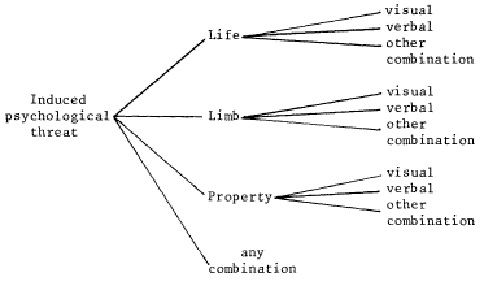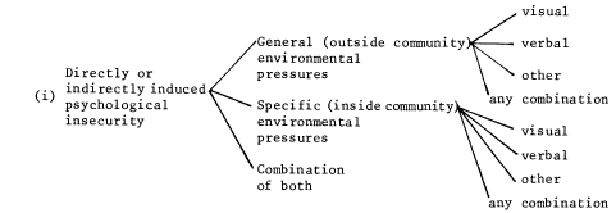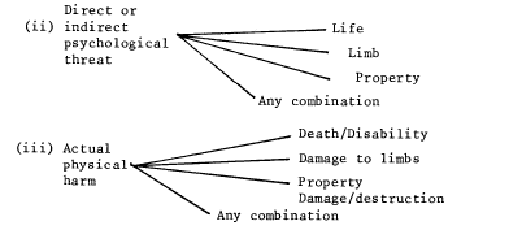
Intimidation in Housing
|
| Intimidation | 
| (i) induced psychological insecurity (ii) induced psychological threat (iii) actual physical harm to people or property (iv) any combination of (1) (ii) (iii) |
(i) Induced psychological insecurity
This category can be subdivided according to 3 basic components,
which in turn are capable of further subdivision -
| Induced psychological insecurity |  | general (outside community environmental pressures
specifice (within community) Combination of both |  | visual verbal other combination
visual |
Psychological insecurity can result from a multitude of occurrences. An example of environmental pressure would occur where a family lives in a general "intimidatory" situation as distinct from one which has been specifically intimidated. The Lenadoon movements where some families moved out because of constant gunfire in the area is a case in point; another relevant example is to be found in Derry where families have evacuated corner houses which were vulnerable to crossfire.
Indirect environmental pressures - neighbours becoming unfriendly; friends lowering their eyes in the street; people refusing to talk to the housewife at the shops; manning of barricades; children having no friends to play with anymore; slogans painted on pavements and street furniture -in their mildest forms can make a family uncomfortable enough for parents to decide that "this is no place to bring up children". And a combination of pressures can induce real psychological insecurity amounting to fear. The evidence indicates that many families have moved on this account; they were unable to prove intimidation and moved from their homes without going to any voluntary group or government agency for help.
(ii) Induced psychological threat

This type of psychological threat can take any form from a poison pen letter or anonymous telephone call to masked men calling at the door. In North Belfast some Catholic families had mass cards posted to them; Protestant families have had slogans painted on their doors. This sort of pressure can be differentiated from induced psychological insecurity because threats are directed against a particular family.
It is often this factor which causes housing movement, although
it is sometimes difficult for the householder to prove that this
type of intimidation has occurred.
(iii) Actual physical harm
Actual physical intimidation is the most potent weapon used by
intimidators, being directed at the life, limbs or property of
families in a minority situation.

Physical harm can take a variety of very nasty forms and combinations,
eg pets or children beaten by other kids because of family religion;
husband or wife jostled or beaten in a variety of situations;
eggs, stones, bottles, petrol bombs or bullets directed through
windows or doors; the house ransacked when vacant or occupied,
furniture piled up in the street or burned; petrol bomb attack
resulting in damage or destruction to the house; a member of the
family shot, injured or killed. The list is almost endless.
(iv) Any combination of (i) (ii) or (iii)
The complexity of intimidation, both in terms of the extremes it can take from blatant physical violence to the application of subtle psychological innuendos, and as regards the permutations and combinations which can confront a family, can be presented in the form of a composite framework:-

IN HOUSING |  |
(iv) Any permutation of (i) (ii) (iii)
Placing intimidation within this framework is an attempt to further an understanding of the complexity of the phenomenon. Given time and qualified research teams conducting perception studies and psychometric tests, it would be possible to elaborate upon or to refute the suggested framework and so to further explain the different types of intimidation and the processes involved.
CAIN
contains information and source material on the conflict
and politics in Northern Ireland. CAIN is based within Ulster University. |
|
|
|||
|
Last modified :
|
||
|
| ||